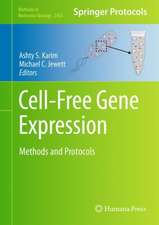Anaerobic Digestion Processes in Industrial Wastewater Treatment: Biotechnology Monographs, cartea 2
Autor Sandra M. Stronach, Thomasine Rudd, John N. Lesteren Limba Engleză Paperback – 17 noi 2011
Preț: 384.31 lei
Nou
Puncte Express: 576
Preț estimativ în valută:
73.53€ • 76.78$ • 60.72£
73.53€ • 76.78$ • 60.72£
Carte tipărită la comandă
Livrare economică 15-29 aprilie
Preluare comenzi: 021 569.72.76
Specificații
ISBN-13: 9783642712173
ISBN-10: 3642712177
Pagini: 200
Ilustrații: X, 184 p.
Dimensiuni: 170 x 244 x 11 mm
Greutate: 0.33 kg
Ediția:Softcover reprint of the original 1st ed. 1986
Editura: Springer Berlin, Heidelberg
Colecția Springer
Seria Biotechnology Monographs
Locul publicării:Berlin, Heidelberg, Germany
ISBN-10: 3642712177
Pagini: 200
Ilustrații: X, 184 p.
Dimensiuni: 170 x 244 x 11 mm
Greutate: 0.33 kg
Ediția:Softcover reprint of the original 1st ed. 1986
Editura: Springer Berlin, Heidelberg
Colecția Springer
Seria Biotechnology Monographs
Locul publicării:Berlin, Heidelberg, Germany
Public țintă
ResearchCuprins
1 The Biochemistry of Anaerobic Digestion.- 1.1 Kinetics of Substrate Utilisation and Bacterial Growth.- 1.1.1 COD Fluxes and Mean Carbon Oxidation State.- 1.1.2 Bacterial Growth and Biokinetics.- 1.1.2.1 Growth and Single Substrate Kinetics.- 1.1.2.2 Multisubstrate Systems.- 1.2 Kinetics and Biochemistry of Hydrolysis.- 1.3 Kinetics and Biochemistry of Fermentation and ?-Oxidation.- 1.4 Kinetics of Methanogenesis.- References.- 2 The Microbiology of Anaerobic Digestion.- 2.1 Nutrient Balance in Anaerobic Digesters.- 2.2 Origin and Nature of Digester Bacteria.- 2.3 The Hydrolysing Bacteria.- 2.3.1 End-Product Inhibition During Hydrolysis.- 2.4 Intermediate Metabolism.- 2.4.1 The Fermenting Bacteria.- 2.4.2 The Bacteria of ?-Oxidation.- 2.5 The Methanogenic Bacteria.- 2.6 Other Bacterial Conversions.- 2.7 Anaerobiosis.- References.- 3 Forms of Biomass.- 3.1 Adhesion.- 3.1.1 The DVLO Theory.- 3.1.2 Interfacial Free Energy and Adhesion.- 3.1.3 Deformation in Relation to Adhesion.- 3.2 Biofilm Formation.- 3.3 Floc Formation.- 3.4 Pellet Formation.- 3.5 Entrapment in Natural Polymers.- 3.6 Estimation of Microbial Mass and Activity.- References.- 4 Influence of Environmental Factors.- 4.1 Temperature.- 4.2 Hydrogen Ion Concentration (pH).- 4.3 Physical Parameters.- 4.4 Nutrients.- References.- 5 Toxic Substances in Anaerobic Digestion.- 5.1 Volatile Acids Inhibition.- 5.2 Sulphide Inhibition.- 5.3 Ammonia-Nitrogen Inhibition.- 5.4 Heavy Metals.- 5.4.1 The Effect of Heavy Metal Speciation in Anaerobic Digestion.- 5.4.2 The Effect of Heavy Metals on the Bacterial Flora of Anaerobic Digesters.- 5.5 The Effect of Cyanide.- 5.6 Anthropogenic and Recalcitrant Compounds in Anaerobic Digestion.- 5.6.1 Response of Digester Systems to Complex Organics.- 5.6.2 Response of AnaerobicBacteria to Hazardous Organic Molecules.- References.- 6 Single-Staged Non-Attached Biomass Reactors.- 6.1 The Continuously Stirred Tank Reactor.- 6.1.1 Design and Operation.- 6.1.2 Process Efficiency.- 6.2 The Contact Process.- 6.2.1 Design and Operation.- 6.2.2 Process Efficiency.- 6.3 The Upflow Anaerobic Sludge Blanket Reactor.- 6.3.1 Design and Operation.- 6.3.2 Process Efficiency.- References.- 7 Single-Stage Fixed-Film Filter and Contact Processes.- 7.1 Anaerobic Filters.- 7.1.1 Design and Operation.- 7.1.2 Process Efficiency.- 7.2 Rotating Biological Contactors.- 7.2.1 Design and Operation.- 7.2.2 Process Efficiency.- 7.3 Carrier-Assisted Contact Reactors.- 7.3.1 Design and Operation.- 7.3.2 Process Efficiency.- 7.4 Hybrid Reactors.- References.- 8 Single-Stage Fixed-Film Expanded Processes.- 8.1 Expanded Bed Reactors.- 8.1.1 Design and Operation.- 8.1.2 Process Efficiency.- 8.2 Fluidised Bed Reactors.- 8.2.1 Design and Operation.- 8.2.2 Process Efficiency.- References.- 9 Developments in Reactor Design.- 9.1 Improvements.- 9.2 Multi-Stage Operations.- 9.3 Two-Phase Digestion.- References.- 10 Start-Up of Anaerobic Bioreactors.- 10.1 Nutrient Balance and Inhibition at Start-Up.- 10.2 Seeding and Loading Regimes.- 10.3 Washout.- 10.4 Turbulence and Shear.- References.- 11 Economic Considerations.- 11.1 Comparisons of Reactor Types and Efficiencies.- 11.1.1 Overloading and Intermittent Operation.- 11.1.2 Tolerance to Toxic Shocks.- 11.2 Wastewater Characteristics.- 11.3 Cost Analyses.- References.- 12 List of Abbreviations.- 13 Subject Index.
























